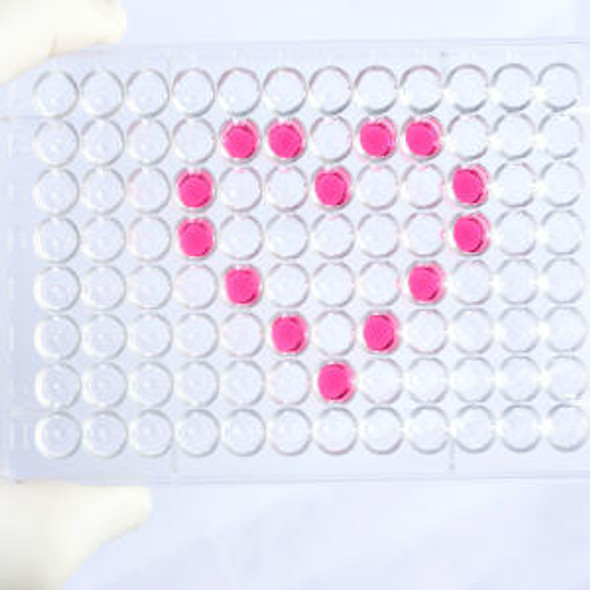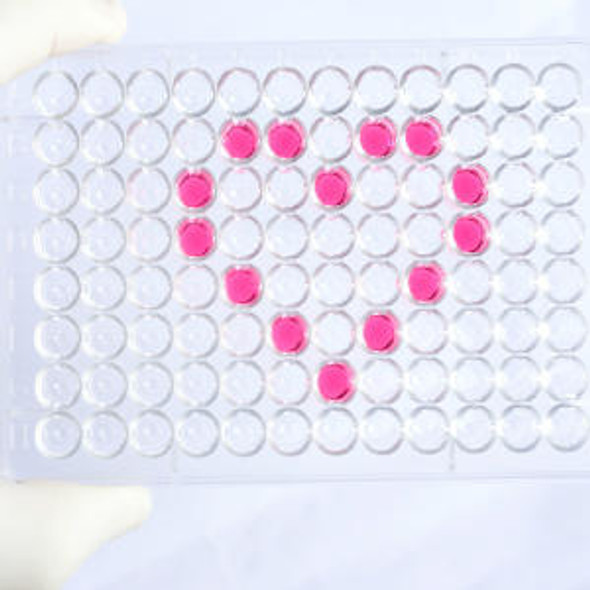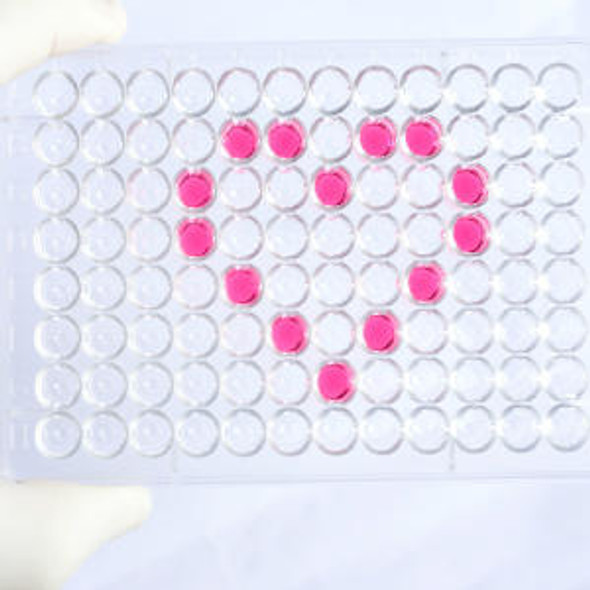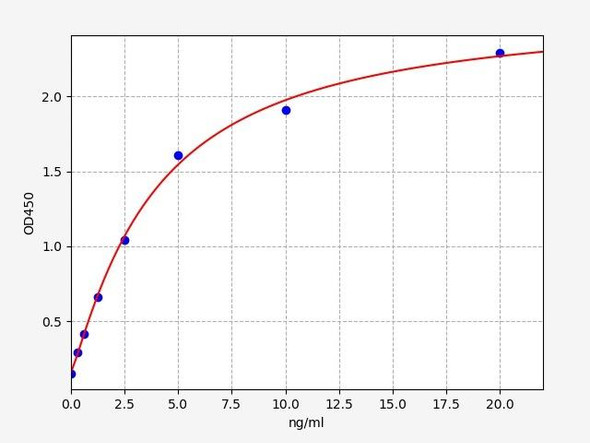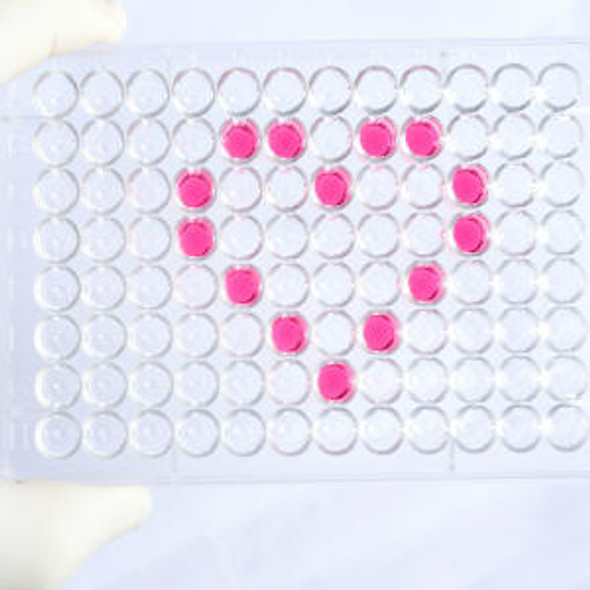Human FOSL1 (Fos-related antigen 1) ELISA Kit (HUFI05210)
- SKU:
- HUFI05210
- Product Type:
- ELISA Kit
- Size:
- 96 Assays
- Uniprot:
- P15407
- Sensitivity:
- 46.875pg/ml
- Range:
- 78.125-5000pg/ml
- ELISA Type:
- Sandwich ELISA, Double Antibody
- Synonyms:
- FOSL1, Fos-related antigen 1, FRA-1, FRA1
- Reactivity:
- Human
Description
| Product Name: | Human FOSL1 (Fos-related antigen 1) ELISA Kit |
| Product Code: | HUFI05210 |
| Size: | 96 Assays |
| Alias: | FOSL1 ELISA Kit, Fos-related antigen 1 ELISA Kit, FRA-1 ELISA Kit, FRA1 ELISA Kit |
| Detection method: | Sandwich ELISA, Double Antibody |
| Application: | This immunoassay kit allows for the in vitro quantitative determination of Human FOSL1 (Fos-related antigen 1) concentrations in serum plasma and other biological fluids. |
| Sensitivity: | < 46.875pg/ml |
| Range: | 78.125-5000pg/ml |
| Storage: | 4°C for 6 months |
| Note: | For Research Use Only |
| Recovery: | Matrices listed below were spiked with certain level of Human FOSL1 (Fos-related antigen 1) and the recovery rates were calculated by comparing the measured value to the expected amount of Human FOSL1 (Fos-related antigen 1) in samples. | ||||||||||||||||
| |||||||||||||||||
| Linearity: | The linearity of the kit was assayed by testing samples spiked with appropriate concentration of Human FOSL1 (Fos-related antigen 1) and their serial dilutions. The results were demonstrated by the percentage of calculated concentration to the expected. | ||||||||||||||||
| |||||||||||||||||
| CV(%): | Intra-Assay: CV<8% Inter-Assay: CV<10% |
| Component | Quantity | Storage |
| ELISA Microplate (Dismountable) | 8×12 strips | 4°C for 6 months |
| Lyophilized Standard | 2 | 4°C/-20°C |
| Sample/Standard Dilution Buffer | 20ml | 4°C |
| Biotin-labeled Antibody(Concentrated) | 120ul | 4°C (Protect from light) |
| Antibody Dilution Buffer | 10ml | 4°C |
| HRP-Streptavidin Conjugate(SABC) | 120ul | 4°C (Protect from light) |
| SABC Dilution Buffer | 10ml | 4°C |
| TMB Substrate | 10ml | 4°C (Protect from light) |
| Stop Solution | 10ml | 4°C |
| Wash Buffer(25X) | 30ml | 4°C |
| Plate Sealer | 5 | - |
Other materials and equipment required:
- Microplate reader with 450 nm wavelength filter
- Multichannel Pipette, Pipette, microcentrifuge tubes and disposable pipette tips
- Incubator
- Deionized or distilled water
- Absorbent paper
- Buffer resevoir
| UniProt Protein Function: | FRA1: an oncogenic transcription factor of the bZIP family, Fos subfamily. The expression of Fos proteins is rapidly and transiently induced by a variety of extracellular stimuli including growth factors, cytokines, neurotransmitters, polypeptide hormones, and stress. Fos proteins dimerize with Jun proteins (c-Jun, JunB, and JunD) to form Activator Protein-1 (AP-1), a transcription factor that binds to TRE/AP-1 elements and activates transcription. Fos and Jun proteins contain the leucine-zipper motif that mediates dimerization and an adjacent basic domain that binds to DNA. The various Fos/Jun heterodimers differ in their ability to transactivate AP-1 dependent genes. In addition to increased expression, phosphorylation of Fos proteins by Erk kinases in response to extracellular stimuli may further increase transcriptional activity. Following growth factor stimulation, expression of FosB and c-Fos in quiescent fibroblasts is immediate but short-lived, while FRA1 and FRA2 expression persists longer. FRA1 is involved in cell motility, invasiveness, and inhibits apoptosis. Elevated in many cancers and associated with tumorigenesis and cancer progression. Involved in Erk2-mediated Epithelial-to-Mesenchymal Transition (EMT) pathway. ERK2/FRA2 regulate ZEB1/2 expression, known to be associated with the EMT. Smad2/3-Fra1 complexes may reflect activation of the Smad/AP-1-dependent TGF‡Ÿ Ÿ Ÿ Ÿ‡Ÿ Ÿ ? ? ? ? ¨-induced breast cancer invasion program. Activation of FRA1/C-JUN by ERK/AKT pathways can induce EZH2 overexpression, silencing integrin alpha-2 expression, and increasing the metastatic potential of colorectal cancer. Belongs to the bZIP family. Fos subfamily. |
| UniProt Protein Details: | Protein type:DNA-binding; Transcription factor Chromosomal Location of Human Ortholog: 11q13 Cellular Component: nucleoplasm; presynaptic membrane; neuron projection; cytosol; nucleus Molecular Function:protein binding; transcription factor activity Biological Process: transcription from RNA polymerase II promoter; response to drug; response to gravity; response to cAMP; positive regulation of apoptosis; in utero embryonic development; response to virus; vitellogenesis; positive regulation of cell cycle; learning; female pregnancy; chemotaxis; regulation of transcription from RNA polymerase II promoter; negative regulation of cell proliferation; response to hydrogen peroxide; response to mechanical stimulus; response to cytokine stimulus; positive regulation of cell proliferation; cellular response to extracellular stimulus; cellular defense response; positive regulation of transcription factor activity; response to progesterone stimulus; response to corticosterone stimulus |
| NCBI Summary: | The Fos gene family consists of 4 members: FOS, FOSB, FOSL1, and FOSL2. These genes encode leucine zipper proteins that can dimerize with proteins of the JUN family, thereby forming the transcription factor complex AP-1. As such, the FOS proteins have been implicated as regulators of cell proliferation, differentiation, and transformation. Several transcript variants encoding different isoforms have been found for this gene. [provided by RefSeq, Jul 2014] |
| UniProt Code: | P15407 |
| NCBI GenInfo Identifier: | 120484 |
| NCBI Gene ID: | 8061 |
| NCBI Accession: | P15407.1 |
| UniProt Secondary Accession: | P15407,Q6FG51, B4DR11, |
| UniProt Related Accession: | P15407 |
| Molecular Weight: | 271 |
| NCBI Full Name: | Fos-related antigen 1 |
| NCBI Synonym Full Names: | FOS-like antigen 1 |
| NCBI Official Symbol: | FOSL1 |
| NCBI Official Synonym Symbols: | FRA; FRA1; fra-1 |
| NCBI Protein Information: | fos-related antigen 1; FOS-like antigen-1 |
| UniProt Protein Name: | Fos-related antigen 1 |
| Protein Family: | Fos-related antigen |
| UniProt Gene Name: | FOSL1 |
| UniProt Entry Name: | FOSL1_HUMAN |
*Note: Protocols are specific to each batch/lot. For the correct instructions please follow the protocol included in your kit.
Before adding to wells, equilibrate the SABC working solution and TMB substrate for at least 30 min at 37 °C. When diluting samples and reagents, they must be mixed completely and evenly. It is recommended to plot a standard curve for each test.
| Step | Protocol |
| 1. | Set standard, test sample and control (zero) wells on the pre-coated plate respectively, and then, record their positions. It is recommended to measure each standard and sample in duplicate. Wash plate 2 times before adding standard, sample and control (zero) wells! |
| 2. | Aliquot 0.1ml standard solutions into the standard wells. |
| 3. | Add 0.1 ml of Sample / Standard dilution buffer into the control (zero) well. |
| 4. | Add 0.1 ml of properly diluted sample ( Human serum, plasma, tissue homogenates and other biological fluids.) into test sample wells. |
| 5. | Seal the plate with a cover and incubate at 37 °C for 90 min. |
| 6. | Remove the cover and discard the plate content, clap the plate on the absorbent filter papers or other absorbent material. Do NOT let the wells completely dry at any time. Wash plate X2. |
| 7. | Add 0.1 ml of Biotin- detection antibody working solution into the above wells (standard, test sample & zero wells). Add the solution at the bottom of each well without touching the side wall. |
| 8. | Seal the plate with a cover and incubate at 37 °C for 60 min. |
| 9. | Remove the cover, and wash plate 3 times with Wash buffer. Let wash buffer rest in wells for 1 min between each wash. |
| 10. | Add 0.1 ml of SABC working solution into each well, cover the plate and incubate at 37 °C for 30 min. |
| 11. | Remove the cover and wash plate 5 times with Wash buffer, and each time let the wash buffer stay in the wells for 1-2 min. |
| 12. | Add 90 µL of TMB substrate into each well, cover the plate and incubate at 37 °C in dark within 10-20 min. (Note: This incubation time is for reference use only, the optimal time should be determined by end user.) And the shades of blue can be seen in the first 3-4 wells (with most concentrated standard solutions), the other wells show no obvious color. |
| 13. | Add 50 µL of Stop solution into each well and mix thoroughly. The color changes into yellow immediately. |
| 14. | Read the O.D. absorbance at 450 nm in a microplate reader immediately after adding the stop solution. |
When carrying out an ELISA assay it is important to prepare your samples in order to achieve the best possible results. Below we have a list of procedures for the preparation of samples for different sample types.
| Sample Type | Protocol |
| Serum | If using serum separator tubes, allow samples to clot for 30 minutes at room temperature. Centrifuge for 10 minutes at 1,000x g. Collect the serum fraction and assay promptly or aliquot and store the samples at -80°C. Avoid multiple freeze-thaw cycles. If serum separator tubes are not being used, allow samples to clot overnight at 2-8°C. Centrifuge for 10 minutes at 1,000x g. Remove serum and assay promptly or aliquot and store the samples at -80°C. Avoid multiple freeze-thaw cycles. |
| Plasma | Collect plasma using EDTA or heparin as an anticoagulant. Centrifuge samples at 4°C for 15 mins at 1000 × g within 30 mins of collection. Collect the plasma fraction and assay promptly or aliquot and store the samples at -80°C. Avoid multiple freeze-thaw cycles. Note: Over haemolysed samples are not suitable for use with this kit. |
| Urine & Cerebrospinal Fluid | Collect the urine (mid-stream) in a sterile container, centrifuge for 20 mins at 2000-3000 rpm. Remove supernatant and assay immediately. If any precipitation is detected, repeat the centrifugation step. A similar protocol can be used for cerebrospinal fluid. |
| Cell culture supernatant | Collect the cell culture media by pipette, followed by centrifugation at 4°C for 20 mins at 1500 rpm. Collect the clear supernatant and assay immediately. |
| Cell lysates | Solubilize cells in lysis buffer and allow to sit on ice for 30 minutes. Centrifuge tubes at 14,000 x g for 5 minutes to remove insoluble material. Aliquot the supernatant into a new tube and discard the remaining whole cell extract. Quantify total protein concentration using a total protein assay. Assay immediately or aliquot and store at ≤ -20 °C. |
| Tissue homogenates | The preparation of tissue homogenates will vary depending upon tissue type. Rinse tissue with 1X PBS to remove excess blood & homogenize in 20ml of 1X PBS (including protease inhibitors) and store overnight at ≤ -20°C. Two freeze-thaw cycles are required to break the cell membranes. To further disrupt the cell membranes you can sonicate the samples. Centrifuge homogenates for 5 mins at 5000xg. Remove the supernatant and assay immediately or aliquot and store at -20°C or -80°C. |
| Tissue lysates | Rinse tissue with PBS, cut into 1-2 mm pieces, and homogenize with a tissue homogenizer in PBS. Add an equal volume of RIPA buffer containing protease inhibitors and lyse tissues at room temperature for 30 minutes with gentle agitation. Centrifuge to remove debris. Quantify total protein concentration using a total protein assay. Assay immediately or aliquot and store at ≤ -20 °C. |
| Breast Milk | Collect milk samples and centrifuge at 10,000 x g for 60 min at 4°C. Aliquot the supernatant and assay. For long term use, store samples at -80°C. Minimize freeze/thaw cycles. |


